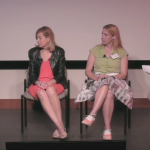It can seem magical…
This is a great chance to talk about how to do exactly that–read in writing systems (what the pros call “orthographies“) that you don’t recognize. In some cases (such as Hindi or Arabic), I can’t even recognize the letter boundaries.
You have to know that there are around 300 different writing systems worldwide, and that’s counting only the current ones. There are plenty of languages out there without ANY writing system, and plenty of languages-that-once-were that are literally lost in time. If you’re interested in these other scripts and other languages, check out the Script Encoding Initiative at UC Berkeley which includes some writing systems that we still can’t read (e.g., Linear A).
But in our current world there are still plenty of scripts and languages that you might run across. Here’s this week’s Challenge about different scripts and languages. How do I read these?
1. For each of these images below: What is the language? What is the translation of the text?
A.
B.
Then I select “Lens” (the circle on the right), which gives me the chance to search for the image, or
And if you wait a moment, it will translate for you (while trying to preserve the color and layout as much as possible). Thus, the top characters (in the Cambodian script, Khmer) spell out “Learn English Introduction” while the bottom Hebrew characters spell out “Significant discount for soldiers in uniform.”
Method 2: Of course, if you’re on a computer, you can right click (or Control-click a Mac), which leads to the same result:
Notice that one of the options is to copy the text in the original orthography. Clicking on the “Text” button will copy the text for you.
A. Khmer – “English Language Introduction”B. Hebrew – “Significant discount for soldiers in uniform”C. Amharic – “Up to date style”D. Arabic – “Deep excavations”
P.S. Sorry about the missing week. It’s not as interesting as Agatha Christie’s 11-day disappearance just a very ordinary case of too many things to do…
















